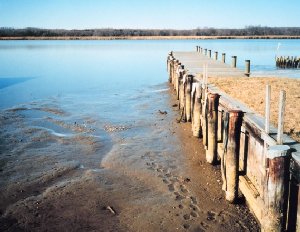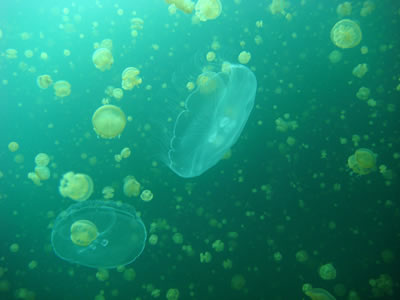Haz "click" en la imagen para una vista completa
Cortesía de NOAA.
Air Pollution and Water
Many people are aware of the fact that water can be contaminated from trash, oil spills, sewage, fertilizers, and chemicals from factories. Few realize that water can also be contaminated from air pollution in the atmosphere.
Several different types of air pollutants are able to enter lakes, streams, rivers, estuaries, and oceans. Some fall as dry particles due to gravity, while other air pollutants fall with rain, snow, or fog. They can enter a body of water directly, or they can fall onto land and enter indirectly with water run-off. Some of these pollutants are listed below. They not only harm water, but also the plant and animal life that depend on water to survive.
Nitrogen compoundsNitrogen compounds supply an unnatural amount of nutrients to a body of water, which can cause a rapid increase in the growth of algae. This is called an algal bloom or “Red Tide.” Records of algal blooms exist from biblical times but they are becoming much more prevalent today. This overabundance of algae can clog waterways and upset the balance of the ecosystem. Some algal blooms are toxic, and since algae are at the base of the food web, their toxins can be transmitted to a wide variety of organisms. In addition to contributing to algal blooms, nitrogen pollution can also contribute to water bodies becoming more acidic.
Sulfur Dioxide and Nitrogen OxidesSulfur dioxide is created most often from industrial processes such as electrical utilities and the burning of fossil fuels. Similarly, the main source of nitrogen oxides is fossil fuel combustion. Both of these air pollutants dissolve in water vapor to form acid, and interact with other gases and particles in the air to form sulfates, nitric acid, and other chemicals that can be harmful to people and the environment. Dry deposits of these pollutants damage property, such as buildings, cars, and metal. Wet deposits refer to acidic rain, snow, and fog, commonly known as “acid rain,” which falls to Earth and eventually enters bodies of water making them more acidic. Areas with limestone rock tend to neutralize acid rain because limestone has a high pH. Bodies of water in areas such as the Northeastern United States and Eastern Canada are more vulnerable to acid rain because rock is primarily granite in both regions, which does not neutralize acid rain.
Acid rain causes a cascade of effects. Certain fish and animals, such as frogs, have a hard time adapting to and reproducing in an acidic environment. At pH 5, most fish eggs cannot hatch, and at lower pH levels some fish die. In fact, some acid lakes have no fish at all. Also, aluminum is released from soils into lakes and streams as acid rain flows through soils in a watershed. This aluminum is harmful to fish as well.
MercuryMercury occurs naturally in the environment. Approximately 2,700 to 6,000 tons of it are released into the atmosphere by gases released from the Earth’s crust and oceans each year. Another 2,000 to 3,000 tons are released each year into the atmosphere by human activities, primarily from burning wastes, and especially from fossil fuels such as coal. Mercury is soluble in water, where bacteria can cause chemical changes that transform it into methyl mercury, a more toxic form. Fish and shellfish can absorb methyl mercury, which in turn can impact fish-eating birds and mammals, including people. When these fish and shellfish are caught and cooked, most of the methyl mercury remains. The United States and other countries test to ensure that commercially sold fish is safe to eat. This is important because high levels of methyl mercury can cause nervous system damage or poisoning.
How can people reduce air pollution’s effect on water? Reducing our use of fossil fuels can make the biggest impact. Turn off lights. Walk, ride a bike, or use public transportation. Every little bit done by each person can add up to a noticeable improvement in air pollution.















